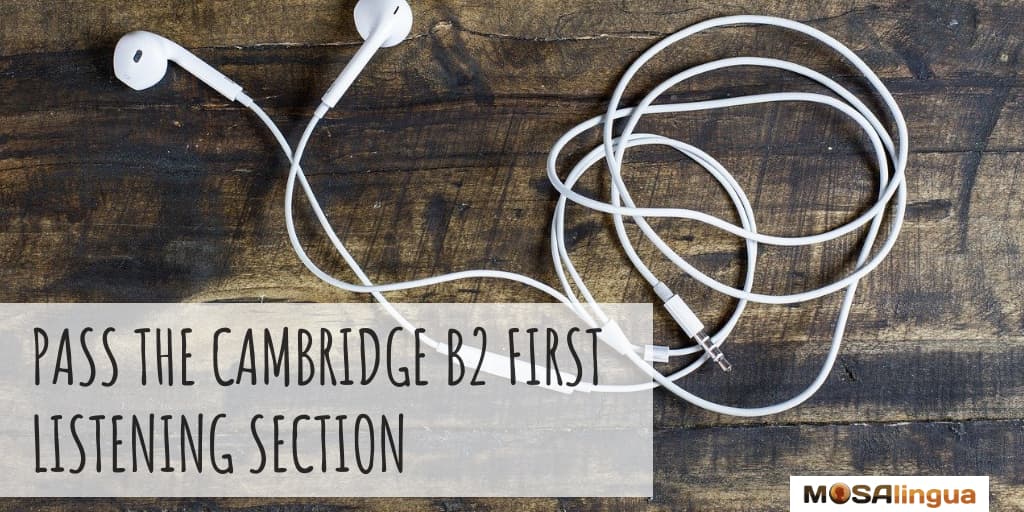Next in our series of articles on the Cambridge B2 First Certificate is the Listening section. This article will give you all the information you need to understand the test and some great techniques to help you succeed. If you plan on taking the Cambridge First exam, it’s important you have the right techniques to pass each section. Make sure you also read our article on the Writing section of the First Certificate to prepare yourself well ahead of time and make sure you get good results.

General Information on the Cambridge B2 First Listening Section
- Length: Around 40 minutes
- Test: 4 parts
- Number of questions: 30
- Grade percentage: 20%
- Purpose: You will demonstrate your ability to understand and analyze a series of listening material, such as the news a presentation, a telephone call, or daily conversations. In each section, you’ll listen to one or more recordings, and then answer questions about what you’ve heard.
How to Prepare for the Listening Section of the Cambridge B2 First
There are a couple of really important steps to prepare yourself for this part of the test. First of all, visit the Cambridge B2 First website for the official guidelines on the test. Click on Listening to see more information about the four parts of the test: what materials you’ll be listening to, how many questions there are, the format of the questions, and most importantly, what you have to practice in order to succeed. Use that information together with this article, and you’ll have a much better chance of doing well.
Next, be sure to brush up on your listening skills. MosaLingua has tons of content to help you out. Check out this video from Luca for some great tips on how to improve your listening skills:
Have you subscribed to our YouTube channel? Click here for more language hacks!
Download the practice tests that are available on the site. This will give you a good idea of what the real test will be like.
Now that you have the materials you need, here are our best recommendations for succeeding on the Listening part of the test, broken down into each of the four sections.
How to Succeed on the Listening Section of the Cambridge B2 First Exam
There are three main techniques you can use to help you successfully complete the Listening section of the test. Try them out as you work on the practice test. More on that in a minute!
- Understand the situation.
You’ll be given a few minutes to read each question before listening to the dialogues. This is your time to prepare for the recording you’re going to hear. The question or text will provide context. That is, tell you more about the situation you’re about to hear. Try to think of the kinds of words that relate to that situation, or the kinds of conversations people might have about that subject. What are the people going to talk about? What kinds of words might you hear?
- Pay attention to tone.
Listen to the tone of the person as they speak. When you are listening to the dialogues, some words will be stressed. They’ll be said more loudly or forcefully, or they’ll be preceded or followed by a pause. This usually means they are important, and may be part of the answer. You’ll hear each recording twice, so the first time around pay attention to any changes in tone, and on the second round be sure to listen carefully to what is said.
- Find synonyms and related words.
For each of the key words that you highlighted to understanding the situation, try to think of synonyms — different words that mean the same thing — and related words. The dialogue you’ll hear doesn’t usually use the exact same words as on the test, so you’ll need to think about different ways to say those things.
About the 4 Parts of the Listening Test
Now we’ll look at each part of the test in detail, to help you fully prepare. Before we get started, download the sample test from the Cambridge B2 First website. This way, you can follow along each section as we go over the best ways to approach the test.
Part I: Multiple Choice — Understanding Conversations
In Part One, you’ll listen to 8 different situations with one or two people talking. Refer to the sample test you downloaded as we go through this section. Your goal is to understand the conversation and answer the question. This part of the test is multiple choice, which means that you’ll be given three answers to choose from, and you have to pick the right one.
Finding synonyms and related words is very useful for this part of the test, because you already have the answers provided to you. For each answer, pick one or two important words, and try to think of different synonyms for them. For example:
You hear two people talking about a programme they saw on TV. The woman thinks the programme was:
A irritating.
B sad.
C uninformative.
For each word, try to think of other words that are similar or related. For example:
- If the woman thought the program was irritating, she might use words like annoying, too long, or not enjoyable.
- If she thought it was sad, she might use words like not cheerful, broke my heart or difficult to watch.
- Finally, if she found it uninformative, she might use words like information, facts or learning.
If you hear one of your synonyms or related words, there’s a good chance you’ve found the right answer. Just be careful: listen closely both times as the test will sometimes use deliberately ambiguous language (words that can have different meanings depending on the situation).
Part II: Fill-in-the-blank — Listening to a story or report
In Part Two, you’ll be given a small text with some words missing from it. Refer to the sample test you downloaded as we go through this section. Your goal is to understand the story or report and fill in the blanks. It may be a story about a person or a situation, or it might be a report or somebody’s opinion about something. The trick to Part Two is to use the words before and after the blank to help you predict what words might go there. Try to think of synonyms and related words based on your prediction. Let’s look at an example:
Angela says that bears usually eat ____________________ and tree bark.
This tells us that whatever word is missing, it’s something that bears usually eat. So you can think about the kinds of things bears eat in the wild: fruits, nuts, berries or fish. Again, you’ll listen to the recording twice, so don’t panic if you don’t get everything the first time around. Fill in the words that you’re sure of the first time around, and then you can concentrate on the ones you missed.
This is another good section to listen to tone. Because there is just one speaker and it’s a longer recording, they will probably emphasize important words. You can use the words before and after the blank to predict the tone the person might use. For example:
Angela is pleased by evidence that spectacled bears have been seen in ________________ areas of Argentina.
In this case, we can see the speaker is pleased by something. You can think about synonyms for pleased, like excited or thrilled, and then also think about the tone she might use if she’s happy.
Part III: Matching Stories to Speakers
In Part Three, you will hear five stories from five different speakers. Refer to the sample test you downloaded as we go through this section. Your goal is to match the story to the speaker, numbered 1 through 5; at the end, you’ll have 3 answers you didn’t use. You’ll hear each story twice.
But be careful — most of the speakers will talk about things they liked and things they didn’t like. Be sure to listen carefully, so you know which is which. This is a great opportunity to use synonyms and related words. For each sentence on the left, try to think of what words the speaker might use. For example:
the efficiency of the public transit system
- Public transit should make you think about trains, buses, trams and subways; and words like getting around and visiting the city.
Here’s another example:
the helpfulness of the people
- Try to think about situations where people need help when traveling. You might listen for we got lost or we couldn’t find our way. And of course, related words to helpfulness: very kind, showed us around, thankful or grateful.
Part IV: Multiple Choice — Listening to a story or report
Part Four is multiple-choice like Part One, and similar in content to Part Two. Refer to the sample test you downloaded as we go through this section. You will listen to one person telling a story or giving a report. The goal is to understand the story and choose the correct answer to each question. Part Four is meant to pull together all the skills you used in the previous three, so be sure to use all your listening techniques here: understand the situation, find synonyms and related words, and listen to tone.
- To understand the situation, make sure you read through each question and the possible answers. The questions will tell you more about the speaker’s subject.
- The questions and answers will give you lots of keywords to find synonyms and related words; many of the important words will be repeated in the recording in this section. You’ll want to be on the look-out for synonyms and related words.
- For subject matter, the speaker might use the words depiction, rendering or what the art’s about.
- For quality, they may use the words standards or good enough.
- Words related to doesn’t like it could be disappointed, hated or wasn’t interested.
What is the most common reason for the gallery not exhibiting an artist’s work?
A The subject matter is unsuitable.
B It is not of a high enough quality.
C The gallery manager doesn’t like it.
- This is a good place to use tone to determine which answer is correct. The question asks what is the most common reason. That means the speaker may talk about more than one answer — but only one is the most important. The tone will help you figure out which one. The speaker may also give clues, like pausing before or after the answer.
The Day Before the Test

The big day is just around the corner! You’re probably feeling a bit nervous, and that’s perfectly normal. If you’ve done as we’ve suggested, you should have brushed up on your listening skills and looked at the sample test to understand what you’ll be doing tomorrow. Here are some suggestions for the 24 hours before the test.
- Don’t spend all day “cramming.” You’ll want to be nice and relaxed when you take the test. If you have any areas of listening that you’d like to improve upon, go ahead and study a little bit more. But you may also want to do something leisurely to relax your mind. Try to do an activity that will passively prepare you for the test. Go to the park and listen to the conversations happening around you. Or watch some TV or Netflix and try to follow along.
- Eat a good dinner, have a good breakfast and drink lots of water. Studies have shown that you perform better on tests if you’re not hungry and you’re well hydrated. If you’re especially nervous, you may not feel like eating, but make sure you still have something. It’s also important to stay hydrated. Remember, about 75% of your brain is water! — so make sure you’ve got plenty of it.
- Get a good night’s sleep. This might be the most important of all. You will do much better on the test if you’re alert and full of energy. Even if you’re feeling anxious about the test, go to bed at a reasonable time. Most people need 7 – 8 hours of sleep to be fully rested. Don’t stay up all night studying — this is a sure way to not do well on the test. Get plenty of rest, and you’ll be all set to succeed.
Conclusion
I hope these techniques will be useful for you before and during the exam. Remember, it’s important to use the right techniques to make your way through the test, so use this page as a reference — go back and read our recommendations as often as you like. There are lots of materials that can help you improve your listening skills. You can use audiobooks, podcasts & movies, plus all the resources available in the MosaLingua app to help you prepare for the Cambridge First Listening portion.
We’d love to hear your comments! Let us know how you prepared for the test, what it was like taking it, and how you did! If there’s any tips you have for new learners, feel free to share them.
Related posts:
Improve your English listening skills

Good news, we have a course for that! MosaSeries English: The Man With No Name. Start your 15-day free trial today and try it risk-free!
MosaSeries is an original and captivating English story divided into short episodes, designed to help you improve your listening skills, broaden your vocabulary, and learn the most important aspects of English grammar.





Comments